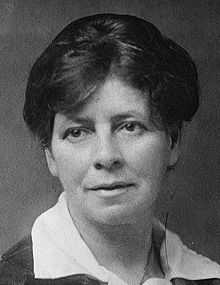Lucy Kemp-Welch
| Lucy Kemp-Welch | |
|---|---|
 | |
| Born |
20 June 1869 Bournemouth |
| Died |
27 November 1958 (aged 89) Watford |
| Nationality | British |
| Education | The Herkomer School |
| Known for | Equine artist |
Lucy Elizabeth Kemp-Welch (20 June 1869 – 27 November 1958) was a British painter and teacher who specialized in painting working horses. She is best known for her illustrations to the 1915 edition of Anna Sewell's Black Beauty.[1] Her younger sister Edith was also an artist.[2] The Lucy Kemp-Welch estate has been represented by Messum's Fine Art since 1975.
Biography
Lucy Kemp-Welch was born in Bournemouth, showing an early excellence in art, exhibiting for the first time when she was 14 years old, and moving to Bushey to study at Hubert von Herkomer’s art school at the age of 19. Kemp-Welch believed in painting out of doors, and made numerous quick oil sketches. As one of Herkomer's best and most favoured students, she was able to set up her own studio, in an old former inn known as 'Kingsley'. She took over the direction of the School after Herkomer in 1905 and ran it until 1926, when she spent several summers following Sanger's Circus, recording the horses.
She resided in Bushey, Hertfordshire for most of her life and a major collection of her works is in Bushey Museum. They include very large paintings of wild ponies on Exmoor, galloping polo ponies, the last horse-launched lifeboat being pulled into a boiling sea, heavy working horses pulling felled timber and hard-working farm horses trudging home at the end of the day. Her interest in equine subjects extended to the use of horses in war, and she painted two Boer War scenes, 'In Sight': Lord Dundonald's dash on Ladysmith (Royal Albert Memorial Museum, Exeter), and Sons of the City (private collection). During World War I, she exhibited Big Guns to the Front (National Museum of Wales, Cardiff), and The Leaders of a Heavy Gun Team (Royal Artillery Institution). The former was painted on Salisbury Plain while eight batteries of horse artillery were continually rode towards her.[3] During World War One women were employed at Army Remount Depots in training and preparing horses for military service. Kemp-Welch painted two scenes at the largest such depot, staffed entirely by women, at Russley Park in Wiltshire.[4]
As well as pictures of horses, Kemp-Welch painted other animals, flowers, and landscapes. Colt-Hunting in the New Forest (1897) became her best-known picture after being purchased for the Chantrey Collection for 500 guineas, and is now in the national collection at Tate.[5]
References
- ↑ Tate. "Artist biography Lucy Kemp-Welch". Tate. Retrieved 22 July 2014.
- ↑ Brian Stewart & Mervyn Cutten (1997). The Dictionary of Portrait Painters in Britain up to 1920. Antique Collectors' Club. ISBN 1 85149 173 2.
- ↑ Tate. "Catalogue entry for Forward the Horses". Tate. Retrieved 22 July 2014.
- ↑ Kathleen Palmer (2011). Women War Artists. Tate Publishing/Imperial War Museum. ISBN 978-1-85437-989-4.
- ↑ Tate. "Catalogue entry for Colt hunting in the New Forest". Tate. Retrieved 22 July 2014.
- Harrington, P. (1993). British artists and war: The face of battle in paintings and prints 1700-1914. London: Greenhill. ISBN 1-85367-157-6
- Messum, D. (1976). Life and Work of Lucy Kemp-Welch. London: Antique Collectors Club. ISBN 0-902028-43-X
- Wortley, L. (1996). Lucy Kemp-Welch, 1869-1958: The Spirit of the Horse. London: Antique Collectors Club. ISBN 1-85149-252-6
External links
| Wikimedia Commons has media related to Lucy Kemp-Welch. |
- Paintings by Lucy Kemp-Welch at the BBC Your Paintings site
- Messum's Fine Art
- Works by Lucy Kemp-Welch (public domain in Canada)
- Works by Lucy Kemp-Welch at Project Gutenberg
|